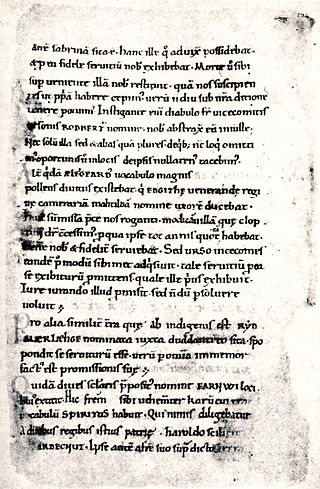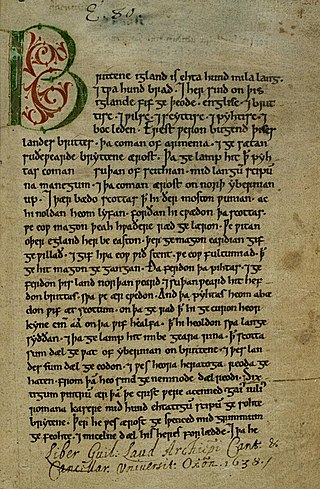
Hereward the Wake was an Anglo-Saxon nobleman and a leader of local resistance to the Norman Conquest of England. His base when he led the rebellion against the Norman rulers was the Isle of Ely, in eastern England. According to legend, he roamed the Fens, which covers parts of the modern counties of Cambridgeshire, Lincolnshire and Norfolk, and led popular opposition to William the Conqueror.
Benedict, sometimes known as Benedictus Abbas, was abbot of Peterborough. His name was formerly erroneously associated with the Gesta Henrici Regis Secundi and Gesta Regis Ricardi, English 12th-century chronicles, which are now attributed to Roger of Howden.

Evesham Abbey was founded by Saint Egwin at Evesham in Worcestershire, England between 700 and 710 following an alleged vision of the Virgin Mary by a swineherd by the name of Eof.

Medeshamstede was the name of Peterborough in the Anglo-Saxon period. It was the site of a monastery founded around the middle of the 7th century, which was an important feature in the kingdom of Mercia from the outset. Little is known of its founder and first abbot, Sexwulf, though he was himself an important figure, and later became bishop of Mercia. Medeshamstede soon acquired a string of daughter churches, and was a centre for an Anglo-Saxon sculptural style.

Peter the Deacon was the librarian of the abbey of Montecassino and continuator of the Chronicon monasterii Casinensis, usually called the Monte Cassino Chronicle in English. The chronicle was originally written by Leo of Ostia. According to both Chalandon and Lord Norwich, Peter is a poor historian and writer, much inferior to Leo.

Hugh Candidus was a monk of the Benedictine monastery at Peterborough, who wrote a Medieval Latin account of its history, from its foundation as Medeshamstede in the mid 7th century up to the mid 12th century.

The Liber Eliensis is a 12th-century English chronicle and history, written in Latin. Composed in three books, it was written at Ely Abbey on the island of Ely in the fenlands of eastern Cambridgeshire. Ely Abbey became the cathedral of a newly formed bishopric in 1109. Traditionally the author of the anonymous work has been given as Richard or Thomas, two monks at Ely, one of whom, Richard, has been identified with an official of the monastery, but some historians hold that neither Richard nor Thomas was the author.
The Chronicon Abbatiae de Evesham or Chronicle of the Abbey of Evesham, sometimes the Evesham Chronicle, is a medieval chronicle written at and about Evesham Abbey in Worcestershire in western England.

Hemming's Cartulary is a manuscript cartulary, or collection of charters and other land records, collected by a monk named Hemming around the time of the Norman Conquest of England. The manuscript comprises two separate cartularies that were made at different times and later bound together; it is in the British Library as MS Cotton Tiberius A xiii. The first was composed at the end of the 10th or beginning of the 11th century. The second section was compiled by Hemming and was written around the end of the 11th or the beginning of the 12th century. The first section, traditionally titled the Liber Wigorniensis, is a collection of Anglo-Saxon charters and other land records, most of which are organized geographically. The second section, Hemming's Cartulary proper, combines charters and other land records with a narrative of deprivation of property owned by the church of Worcester.

The Anglo-Saxon Chronicle is a collection of annals in Old English, chronicling the history of the Anglo-Saxons.
The Historia Ecclesie Abbendonensis or History of the Church of Abingdon was a medieval chronicle written at Abingdon Abbey in England in the 12th century. The Abbey was historically in the county of Berkshire, but since 1974 has been in the county of Oxfordshire.
Joseph Sparke or Sparkes (1683–1740) was an English antiquary, editor of some significant chronicles.
The Chronicon Angliae Petriburgense is a 14th-century chronicle written in Medieval Latin at Peterborough Abbey, England, covering events from 604 to 1368, although the original manuscript ends with an entry for 868, and the remainder was added in the 17th century. It survives as part of a composite manuscript volume held at the British Library with the mark Cotton Claudius A.v, in which it appears on folios 2–45. An edition of the Chronicon was published in 1723 by Joseph Sparke, in a collection of English histories by various writers. According to John Allen Giles, in the preface to his own edition published by the Caxton Society in 1845, the Chronicon was attributed by both Simon Patrick and Henry Wharton to John of Caleto, who was an abbot of Peterborough (1250–1262). Giles reported a marginal note in the manuscript making a similar attribution, besides a similar note at the beginning of the manuscript stating that it belonged to Peterborough Abbey. However, Giles observed that this manuscript attribution was "comparatively modern", and regarded the chronicle's author as unknown. In Giles's view, the Chronicon is "extremely valuable both on account of the numerous facts which it contains, and for the [700 years] which it embraces."
Liber Niger may refer to:
Thomas Stapleton (1805–1849) was an English landowner and antiquary.

Morville Priory was a small Benedictine monastery in Shropshire, England, a cell of Shrewsbury Abbey.

The Northamptonshire Record Society is a text publication society for the English county of Northamptonshire. It was established in 1920 by Joan Wake. The society is based at Wooton Hall Park in Northampton, with the Northamptonshire Record Office. It is a registered charity.

Dale Abbey, also known as the Abbey of Stanley Park, was a religious house, close to Ilkeston in Derbyshire. Its ruins are located at the village of Dale Abbey, which is named after it. Its foundation legend portrays it as developing from a hermitage, probably in the early 12th century.
Pierre Coral was a French monk and historian. He was the prior of Saint-Martin de Limoges, then abbot from 1247 until 28 August 1276, when he became the abbot of Tulle, a position he held until his death. He was buried in Tulle next to the altar of Saint Martin.
Henry of Poitou - not to be confused with Henry of Antioch who was also known as Henry of Poitou - thought to be the son of William VII of Poitou. Henry was an ecclesiastic, and, according to the Peterborough Chronicle, held a number of titles throughout his career. He was a sworn witness attesting to the consanguinity of William Clito and Sybilla of Anjou, which led to the annulment of their marriage in 1124 by Pope Calixtus II.











